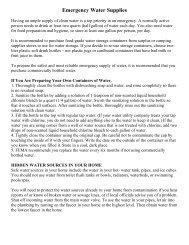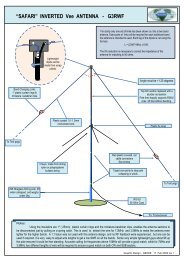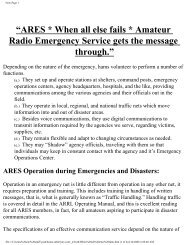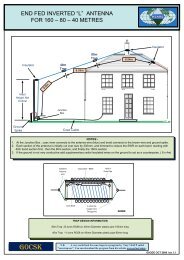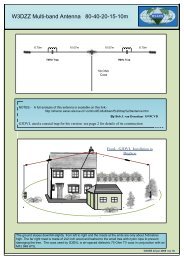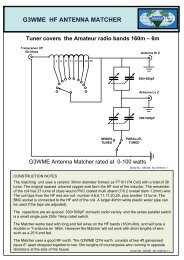Inernational HAM Magazine 100% HAM RADIO - arkansas ares races
Inernational HAM Magazine 100% HAM RADIO - arkansas ares races
Inernational HAM Magazine 100% HAM RADIO - arkansas ares races
You also want an ePaper? Increase the reach of your titles
YUMPU automatically turns print PDFs into web optimized ePapers that Google loves.
As might be expected with any older test equipment, your “new” VTVM will likely need a little care<br />
before it can serve reliably on your bench. All paper based capacitors over time will become<br />
leaky—and require replacement. Depending upon the age of your unit is may be wise to simply replace<br />
the coupling and any electrolytic capacitors that may be present in the circuit.<br />
Rotary control switches and adjustable potentiometers become dirty through oxidation and<br />
contamination. These should be cleaned with a quality solution such as a spray on cleaner/lubricant or<br />
an application of a solution such as DeoxIT. This applies to calibration trimmers as well—a thorough<br />
cleaning and recalibration as given in the instruction manual is recommended.<br />
Interestingly, quite a few VTVM’s used a battery to supply the resistance measurement voltage. A first<br />
check of the interior of the meter will look at replacing this battery and repairing any damage done by<br />
leakage of an old cell. Some enterprising technicians have tapped into the tube filament voltage to feed<br />
a circuit that provides a stable 1.5 volt DC supply—thus eliminating the need for a battery.<br />
Once the dominant instrument in any electronics shop, the venerable VTVM still has a valuable place<br />
on the radio amateur’s bench.VTVM Sidebar Resources<br />
Although it has been many years since the majority of VTVM’s were made, a wealth of resource<br />
material is still available to the bench technician and hobbyist. A quick search of Amazon.com turned<br />
up nearly 20 unique used books detailing meter operation and a variety of troubleshooting techniques.<br />
The most complete reference for these meters is “The VTVM” by Rhys Samuel. Originally published in<br />
the mid1950s, copies in hard and soft cover are still available at a reasonable price. As noted, it is<br />
important to have a manual for your VTVM. If one did not come with your meter, a number of online<br />
resources exist that will provide you with one.<br />
Here is a list of a resources for the new VTVM user:<br />
Books<br />
101 Ways To Use Your VOM and VTVM<br />
Robert G. Middleton, 1959<br />
Troubleshooting With The VOM and VTVM<br />
Robert G. Middleton, 1962.<br />
Know Your VOMVTVM<br />
Joseph A. Risse, 1963.<br />
The VOMVTVM Handbook<br />
Joseph A. Risse, 1972.<br />
On The Web<br />
BAMA Manuals & Schematics<br />
http://bama.sbc.edu/index.htm<br />
73 from N4PRT<br />
[ <strong>HAM</strong>MAG N.14 March 2010 ]



